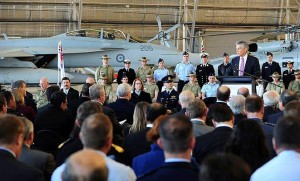
The Prime Minister Julia Gillard and Minister for Defence Stephen Smith today announced the acquisition of 12 new-build Boeing EA-18G Growlers electronic attack aircraft to help cover the transition to a RAAF air combat fleet of at least 72 F-35 Joint Strike Fighters. The news came at the same time as the government released its 2013 Defence White Paper.
The acquisition would see the current fleet of 24 F/A-18E/F Super Hornets retained in their current air combat and strike capability configuration, rather than converting 12 of the jets to Growler configuration, as had previously been planned.
Speaking at the announcement, Ms Gillard said the government was committed to the F-35 program and remained confident of the capability and deliverability of the development program.
Mr Smith said there was no current plan by government to further adjust the timetable for the Australian F-35 acquisition, which would see the first two aircraft delivered to the RAAF between 2014 and 2015, and three operational squadrons planned to enter service around 2020.
Mr Smith said a decision could be made by future governments on replacing the Super Hornets with additional JSF aircraft around their expected 2030 withdrawal date.
F-35 prime contractor Lockheed Martin said it was honoured by the trust and confidence shown by the Australian government.
“Along with the first two Australian jets in production, which will deliver in mid-2014, we will work closely with the government to support their purchase of their remaining 100 F-35 aircraft,” the statement said.
“Additionally, we will work with Australian industry supporting their participation in the production of components and sub-assemblies for the more than 3,000 F-35s to be built during the life of the program. The projected $5.5 billion of industrial participation will bring long term economic benefits to Australia for decades.”
Reaction from ASPI, the Australian Strategic Policy Intitute, has also been positive.
“Simply put, buying more Super Hornets retires much of the risk associated with relying on 1980s jets to form the bulk of our air combat capability. And buying Growlers off the production line rather than taking half of the existing 24 off line for conversion means that the RAAF will have their most capable aircraft continuously available,” blogged ASPI’s Andrew Davies.
“The downside to this decision is that the RAAF will be operating a mixed fleet of Super Hornets and F-35s for the entire 2020s, with the operating cost hit of two sets of fixed costs. That will be offset to some extent by a reduced buy of F-35s—now 72 rather than the 100 that had been pencilled in. The overall capability in the late 2020s will probably be less than might have been the case had we persevered with the full transition to the F-35, but the capability between now and the mid 2020s will be higher. And future governments can always revisit the air combat fleet size and composition if circumstances demand it.”












